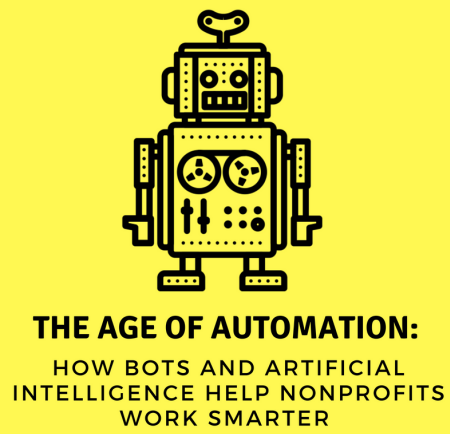
NYC Event: On Thursday, July 12th, Allison Fine and I will be leading an event at the NYC Tech Club on Bots, AI, and Nonprofits. If you are in NYC, you are invited to join us! We will be talking about emerging best practices for using bots and artificial intelligence for nonprofits for fundraising, marketing, program delivery, advocacy, and internal management. We’ll cover different examples, discuss how nonprofits can be prepared, and cover the challenges and cautions as we enter a new age of technological disruption by robots!
Allison Fine and I have been researching and writing about the age of automation and nonprofits. The age of automation, a term coined by Jeremiah Owyang, refers to a family of technologies such as bots, robots, artificial intelligence, machine learning, and smart devices. We’ve written about some early adopter nonprofits are harnessing the power of these tools for fundraising and marketing (published on Guidestar blog) and the larger issues for program delivery and civil society (published on the SSIR blog).
This post looks at how some nonprofits are using bots and artificial intelligence for internal management and administration to work smarter.
Ask anyone who works in the nonprofit industry what one of their biggest challenges is and they will most likely say something like “lack of time to implement everything that needs to be done.” (That is usually second after money.) The Age of Automation technology tools will offer nonprofits a gift: the give of more time to get more work done and an easy way to delegate boring administrative tasks, known as “grunt work,” to an algorithm or a bot. (I can hear nonprofit interns all over the world applauding)
One of my favorite examples is how international development agency OxFam is using bots internally as part of using Facebook’s “Workplace for Good” platform, a free version of Facebook’s internal collaboration tool and a competitor to platforms such as Slack, Hipchat, and Microsoft’s Teams.
Facebook Workplace allows users within an organization (and across multiple organizations) to communicate, connect, coordinate, and collaborate across desktop and mobile versions, using familiar Facebook interfaces such as Facebook groups, Messenger and Live Streaming. It has the ability to integrate with a variety of tools, including commonly used video conferencing tools as well as those powered by bots and artificial intelligence.
Facebook’s Workplace has the ability to unleash virtual assistants or internal bots to help staff get stuff done. Workplace for good users can @mention a bot to initiate a task or workflow, similar to Slack. As you might expect, when tasked with something, the bot will take action and reply back with relevant information. Bots can also be used to deliver important notifications and reminders.
Oxfam, an international nonprofit with 20 affiliates that work with organizations in 90 countries. With over 10,000 employees, Oxfam faced the challenge of balancing separate hierarchies and encouraging innovation while at the same time providing central leadership and decision making. Oxfam uses an internal suite of internal bots and automation tools that help alleviate boring and time-consuming tasks. Oxfam created the OxBot is a jargon-busting bot.
This might not sound like much, but this account by an Oxfam intern shares how difficult it is for a newcomer to the organization, newly hired staff or interns, to master all the inside jargon. It takes effort such as creating your own glossary, asking other employees, or resorting to googling terms. Imagine trying to decode vocabulary and concepts while trying to complete a task – it slows you down. The Oxbot to the rescue – like other bots you can ask it what an acronym means and the bot also provides links to other internal sources of information.
That is just one example of how bots can help nonprofits free up time, a precious resource in nonprofits, to get work done.
Is your nonprofit using an internal-facing bots for productivity and collaboration? How?

Leave a Reply